Cymbidium Orchid
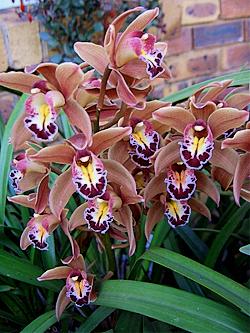 Condensed Version:
Condensed Version:
Often we are given orchids as gifts, or just can’t resist buying them ourselves when they are in full bloom. The problem is what do we do with them when they are finished blooming indoors? Cymbidiums are easy to grow indoors and outdoors and a good choice for the amateur grower because they tolerate a wide range of growing conditions. However, in order to flower beautifully it is vital that these orchids are placed in the right amount of light, both indoors and outdoors. They love bright, diffused light, but no strong direct sunlight. The colour of the leaves will give you a good indication if the light is correct; they should be slightly yellow-green; deep green leaves indicate that the plant is receiving too much shade. Cymbidiums will grow happily in dappled shade underneath trees, shrubs and perennials; and can be watered and fed in the same way as your other plants. They also tolerate cold temperatures if planted underneath the eaves of the house, on the patio, or underneath evergreen shrubs and trees. Protect them from severe frost and cold winter winds which will damage the flowers. Cymbidiums can become quite large, so allow them space to grow and give them adequate air circulation. Miniature Cymbidiums will tolerate less difference in daytime temperatures and are therefore more suitable for growing in warmer regions and at the coast.
Water your potted plants and those growing in garden beds about three times a week in summer; keeping the growing medium slightly moist but not soggy. Reduce watering in winter to help initiate flower spikes. Mist spray the plants often during hot, dry weather, or stand potted plants in trays filled with damp gravel. Potted plants should be fed regularly with a special orchid food; those growing in the garden can also be fed with a specialist feeder, or you can feed them in summer with the same fertilisers you use on other flowering plants. In winter the change in temperature initiates the flower spikes, so start feeding already in autumn with a feeder high in potassium. There are many mixtures available for growing cymbidiums, such as pine bark, compost, rock wool, peanut shells etc. Any good orchid mixture is fine as long as it is relatively water retentive, yet still drains well. If you are growing your plants in garden beds, incorporate lots of compost and any of the above to ensure that drainage is excellent.
Full Version:
Description, History & Interesting Facts:
The genus Cymbidium in the Orchid family consists of about 50 species native to southern and eastern Asia and Australia; where in their natural habitat they often attach themselves to trees. Thousands of hybrids have been bred over the past century and cymbidiums now come in all colours except true red and blue. They flower for many months from July to December and are available in stunning shades of pink, maroon, yellow, orange, green and copper. Cymbidiums are grown as long lasting cut flowers.
Uses:
Besides being excellent for the vase, these orchids are non-toxic and edible. In fact, in South Asia's Bhutan, where they are called ‘olachotho’, they are part of the local diet and considered a delicacy. The most common method of cooking ‘olachotho’ in Bhutan is with cheese. The flowers (unopened or opened) are separated from the inflorescence and washed with water. The cleaned flowers are then boiled in water for 10 minutes till slightly soft. A local cheese is then added together with salt and chillies and simmered until tender. Olachotho is usually served with local brown rice. This orchid is quite bitter and needs to be cooked in a way that tempers the bitterness; garlic, onions and tomatoes also go well with Cymbidium, as does mustard seed and turmeric. The flowers and leaves are also edible and villagers eat the cooked pseudo bulbs with a bit of salt, much like a potato.
In the Garden and Home:
Cymbidiums are tolerant of a wide range of conditions and good choice for the amateur grower. Light and water are the most important factors in growing healthy plants that flower well; together with regular feeding. They can be placed indoors or outdoors and will tolerate moderate frost if planted underneath the eaves of the house, on the patio, or underneath evergreen shrubs and trees. Protect them from severe frost and cold winter winds which will damage the flowers.
 Cultivation:
Cultivation:
It is vital that these orchids are placed in the right amount of light both indoors and outdoors in order to flower beautifully. They love bright, diffused light, but no strong direct sunlight. The colour of the leaves will give you a good indication if the light is correct. They should be slightly yellow-green; deep green leaves indicate that the plant is receiving too much shade.
Water your potted plants and those growing in garden beds about three times a week in summer; keeping the growing medium slightly moist but not soggy. Reduce watering in winter to help initiate flower spikes. Mist spray the plants often during hot, dry weather, or stand potted plants in trays filled with damp gravel. Potted plants should be fed regularly with a special orchid food; those growing in the garden can also be fed with a specialist feeder or you can feed them in summer with the same fertilisers you use on other flowering plants. The change in temperature in winter initiates the flower spikes; so start feeding already in autumn with a feeder high in potassium.
There are many mixtures available for growing cymbidiums, such as pine bark, compost, rock wool, peanut shells etc. Any good orchid mixture is fine as long as it is relatively water retentive, but still drains well. If you are growing your plants in garden beds, incorporate lots of compost and any of the above to ensure that drainage is excellent.
Cymbidiums can become quite large, so allow them space to grow and give them adequate air circulation. Miniature Cymbidiums will tolerate less difference in daytime temperatures and are therefore more suitable for growing in warmer regions and at the coast.
Propagation:
If your plant is overcrowded or pot bound it can be split and re-potted in spring when it has finished flowering. Always leave 3 or 4 pseudo bulbs on every piece to supply nutrients to the plant for the season. Use a container large enough to allow for another 2 years growth. Remove any dead or dying plant material and gently shake off any excess, old potting mix. The old pseudo bulbs, which are called back-bulbs, can be removed and their base inserted into river sand, to encourage new roots to form.
Pests & Diseases:
Cymbidiums are relatively pest and disease free but pests such as snails and slugs, mealy bugs, red spider mites and scale insects may attack orchids. In addition, aphids are attracted to the flowers and buds. Use caution when using any insecticide to rid orchids of pests. An insecticidal soap or insecticide with a spreader sticker (substances added to pesticides to make them spread and stick to a surface more easily) can be used on the leaves to control pests but should not be used on the flowers or buds as this could result in deformation of the blooms.
Warning:
Cymbidium orchids are non-toxic and are actually edible. While allergies to orchids may be rare, there have been reported cases of contact dermatitis from orchids. People can develop sensitivities to plants so they should be aware if they develop skin problems. Cymbidium orchids are not listed as a toxic plant for cats or dogs. However, generally it is recommended that animals not be allowed to munch on plants, as ingesting plant materials could cause vomiting or diarrhoea.
Pansy Orchid - Miltoniopsis
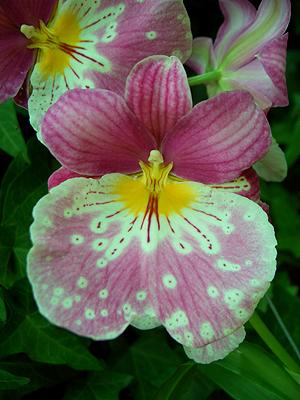
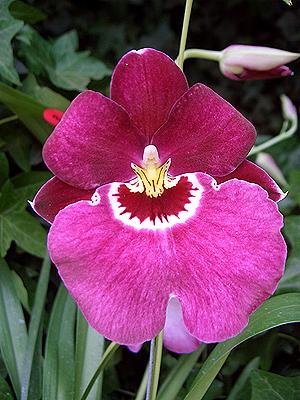 These orchids come mainly from Colombia and Ecuador and have very specific needs. They love humidity but in a shaded, cooler position, (60 to 70% shade), with ample air movement, but no draughts. Grow them in small pots, in a special orchid mix, (available at your local nursery.)
These orchids come mainly from Colombia and Ecuador and have very specific needs. They love humidity but in a shaded, cooler position, (60 to 70% shade), with ample air movement, but no draughts. Grow them in small pots, in a special orchid mix, (available at your local nursery.)
In dry regions, mist them down regularly with rain water. Water them twice a week in summer and once a week in winter, with rainwater, if possible. If you dont have rainwater, use tap water, but let it stand for a couple of days before using it. Feed them once a month with any orchid food.
Pansy Orchids grow outdoors in warm, moist, temperate regions, but must be grown as an indoor pot plant in cold areas.
Lady's Slipper Orchid - Paphiopedilum hybrids
 Slipper OrchidsThese orchids are native to Eastern Asia, the Philippines, Malaysia and Malucca, where they are mainly terrestrial, but sometimes epiphytic. They are continually being hybridised and new varieties released.
Slipper OrchidsThese orchids are native to Eastern Asia, the Philippines, Malaysia and Malucca, where they are mainly terrestrial, but sometimes epiphytic. They are continually being hybridised and new varieties released.
Slipper orchids make good houseplants as they do not require as much light as other orchids. They will grow +- 300 to 600mm tall.
They can be grown outdoors in warm, moist, temperate regions in about 70% shade; as too much light will inhibit their flowering. They must be grown indoors in cold or dry regions. The green leaved varieties will tolerate a minimum night temperature of +-10 degrees C and the mottled varieties +-18 degrees C. An occasional drop in temperature to 4 degrees C will not damage your plants. They are both happiest in daytime temperatures of between 20 to 26 degrees C, but will tolerate short hot spells of up to 37 degrees C.
Place them in a well-ventilated position; with no draughts and pot them into small pots with a well-drained orchid mix. The soil should never be allowed to dry out. Re-pot every two years or so, in spring. Feed with any orchid food monthly and try to water your plant and mist spray the leaves often with rain water.
Vanda Orchid
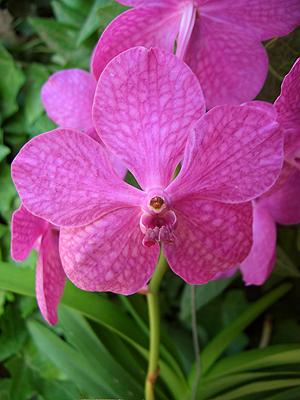
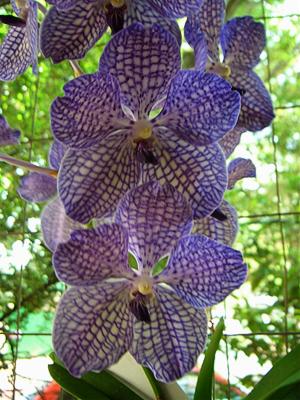 This genus of orchids, with about 50 species comes from Sri Lanka and India, across Southeast Asia to New Guinea and Northeastern Australia, where they grow on rocks and trees. They can flower almost all year round and the flowers are long lasting and often highly fragrant. Most modern hybrids come from V. sanderiana and V. coerulea.
This genus of orchids, with about 50 species comes from Sri Lanka and India, across Southeast Asia to New Guinea and Northeastern Australia, where they grow on rocks and trees. They can flower almost all year round and the flowers are long lasting and often highly fragrant. Most modern hybrids come from V. sanderiana and V. coerulea.
These orchids enjoy humidity, bright light and warm temperatures all year round. They must have free air circulation, without draughts, excellent drainage and are therefore grown in coarse bark. Allow them to dry out between watering. In summer, water them well, 4 to 5 times per week and in winter water them less, 2 to 3 times per week; especially in cold areas. Healthy plants develop thick white roots. Collect rainwater to spray the leaves down with. In cold regions ensure that the night temperature does not drop below 18 degrees C. They can be grown outdoors in warm, moist temperate regions, in semi-shade to sun.
Grow them indoors in cold areas ensure that the night temperature does not drop below 18 degrees C. Re-pot at any time in subtropical and tropical regions, and in spring in cold regions. Feed them monthly with any orchid food. They vary in height from +-20 to 50cm wide and +-20 to 120cm tall.
Colmonara Orchid
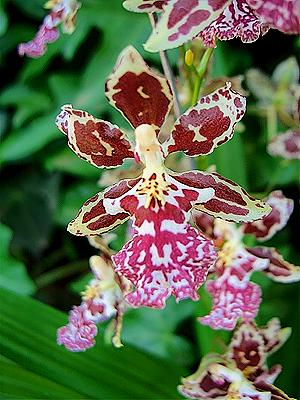 These beauties are grown for their rich colours and striking patterns. They grow outdoors in warm, humid, moist regions but prefer a cooler position (70% shade), with good light. Colomnara bear tall flower spikes +-20 to 75cm tall and will spread +- 20 to 30cm wide. In cold areas they must be grown indoors.
These beauties are grown for their rich colours and striking patterns. They grow outdoors in warm, humid, moist regions but prefer a cooler position (70% shade), with good light. Colomnara bear tall flower spikes +-20 to 75cm tall and will spread +- 20 to 30cm wide. In cold areas they must be grown indoors.
Water them regularly all year round, never allowing the roots to dry out.Feed them once a month with any orchid food. They love humidity, so collect rainwater to water and spray them with, especially in dry regions.
Dancing Lady Orchid - Oncidium
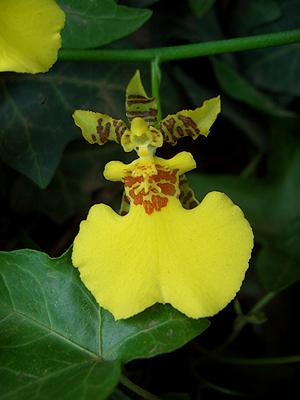 Oncidium 'Yellow' Background leaves are Ivy. There are over 650 different species of these beauties from tropical America. They can be grown outdoors in warm, moist, temperate regions, but must be grown indoors in cold areas. They prefer a cooler position with bright light, (60% shade outdoors). Feed them with any orchid food monthly.
Oncidium 'Yellow' Background leaves are Ivy. There are over 650 different species of these beauties from tropical America. They can be grown outdoors in warm, moist, temperate regions, but must be grown indoors in cold areas. They prefer a cooler position with bright light, (60% shade outdoors). Feed them with any orchid food monthly.
Most species are grown mounted, or in baskets, which allow inimpeded development of the root system and allows the roots to dry out quickly after watering. Water them twice a week in summer and once a week in winter, allowing them to partially dry out between watering. They love constant humidity, so collect rainwater to spray them down with frequently, especially in dry areas. The flower sprays will grow +- 120cm long and it will grow +-90cm wide.
Epidendrum Orchid
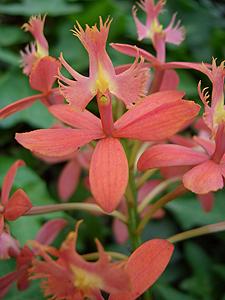 Epidendrum 'Salmon' These small beauties are fairly easy to grow and come from Central and South America, there are about 1 000 recognised species. Many of them grow in grasslands, often in full sun, others grow on trees. They can flower all year round and come in shades of red, white, orange, yellow and purple.
Epidendrum 'Salmon' These small beauties are fairly easy to grow and come from Central and South America, there are about 1 000 recognised species. Many of them grow in grasslands, often in full sun, others grow on trees. They can flower all year round and come in shades of red, white, orange, yellow and purple.
They are grown outdoors in warm, moist, temperate regions, but must be grown indoors in cold areas. Plant them in very bright light. Feed them with any orchid food once a month and water them when they are almost totally dry, about twice a week in summer and once a week in winter. In dry regions, mist spray your plant down often with rainwater.
...................................................................................................................................
Amaryllis - Hippeastrum
 Amaryllis Symphony 'Rozetta' Picture courtesy www.hadeco.co.zaCondensed Version:
Amaryllis Symphony 'Rozetta' Picture courtesy www.hadeco.co.zaCondensed Version:
Amaryllis are commonly sold for the Christmas holiday season. Their magnificent trumpet-shaped blooms demand attention as they stand proudly facing outwards, atop tall thick stems, and come in fabulous shades of pink and magenta, to salmon, orange, red, and white. Varieties include single flowered, and many with stripes or contrasting edges, and the double flowers from Japan are particularly beautiful. New hybrids can produce huge flowers up to 22cm across, and a single stem will produce 4 flowers, and large bulbs may produce 2 stems. The latest (Sonatini hybrids) are true miniatures with blooms between 6 and 12cm across.
In the garden Amaryllis will grow in most good, well-drained soils, and enjoys sun to semi-shade. To make the flowers last longer in hot regions you need to plant them where the blooms are shaded at midday. Water your plants regularly in summer, never allowing the soil to dry out totally, and feed every two weeks during the growing season with a special bulb food or liquid fertiliser for flowering plants.
Bulbs grown in the garden can be left in the soil while dormant provided it is free draining and temperatures don’t drop below freezing in winter. The bulbs will continue to multiply and will only require dividing when they become overcrowded. If you live in the winter rainfall regions, or have a small garden, you may wish to lift and store the bulbs at the end of summer. Do this only once the foliage has died down naturally in autumn, as this is when the bulb is storing up reserves for the new flowers forming inside.
If you are planting bulbs into containers, it is best to do so before they begin to sprout, and if they are already showing signs of growth, it is important to plant them immediately. Amaryllis do not like big pots, preferring to fit snugly into smaller ones, so select a pot only 3cm larger in diameter than the bulb. Use a good potting mixture that drains very well, and plant so that the top third of the bulb is visible above the potting mixture. Place the pot in a warm location and water sparingly until the flower stem appears, then increase watering. Check your plants regularly, because flowering plants are thirsty. Because Amaryllis do not like standing in water, empty excess water from drip trays, and turn the pot regularly so that the plant grows straight.
Amaryllis bulbs take approximately 6 to 8 weeks to bloom once planted out. Deadhead individual spent flowers, and when all the flowers on a stalk are spent, cut it off at the base and allow the plant to continue growing. Towards the end of summer gradually reduce watering so that the leaves die back naturally. Once all the leaves are brown, cut them off and allow the bulb to rest by either leaving it in its pot without watering it, or by lifting and storing the bulb in a paper bag placed in a cool, dry place, for at least 2 months. When the bulb is ready to grow again it will start to produce a green leaf or stem, and can then be planted again in fresh soil and watered.
If you are growing your amaryllis indoors, planting and caring for them is the same as for potted specimens growing outdoors. Indoors they will require very good, bright light, and although they don’t need sun, a little sunlight won’t harm them either.
 Amaryllis 'Christmas Star' Picture courtesy www.hadeco.co.zaFull Version:
Amaryllis 'Christmas Star' Picture courtesy www.hadeco.co.zaFull Version:
Description, History & Interesting Facts:
Popular for their festive oversized flowers, amaryllis are commonly sold for the Christmas holiday season. Their magnificent trumpet-shaped blooms demand attention as they stand proudly facing outwards, atop tall thick stems, and come in fabulous shades of pink and magenta, to salmon, orange, red, and white. Varieties include single flowered, and many with stripes or contrasting edges, and the double flowers from Japan are particularly beautiful.
New hybrids can produce huge flowers up to 22cm across, and a single stem will produce 4 flowers, and large bulbs may produce 2 stems. The latest (Sonatini hybrids) are true miniatures with blooms between 6 and 12cm across. Although this may not sound small, for Amaryllis flowers it is, and what these miniatures lack in stature they more than make up for in generosity, with each bulb giving as many as 3 flower spikes, crowned with up to 6 delightful blooms each!
Amaryllis must be one of the easiest bulbs to grow, and most will bloom approximately five to six weeks after they are planted, and each bulb will generally produce at least four healthy leaves in order to bloom well next season. Some species will grow leaves and bloom at the same time, while others will grow leaves only after they have bloomed.
The plants we commonly call “Amaryllis” are actually Hippeastrum hybrids, and the name Amaryllis correctly belongs to our indigenous Amaryllis belladonna (Belladonna Lily) a genus with only one species, which can be found growing wild in the south-western Cape. Hippeastrums, on the other hand, hail from tropical and subtropical regions of the Americas, from Argentina north to Mexico and the Caribbean.
 Amaryllis 'Sonatini Assorted' Picture courtesy www.hadeco.co.zaIn the 18th century Dutch growers imported the first bulbs from South America to grow commercially, and this continued into the 19th century with even more botanists and explorers bringing back Hippeastrum species from South American countries. These magnificent blooms truly captured the imagination of plant breeders who worked diligently to create new hybrids and cultivars for the markets. Breeding developments continued throughout the second half of the 20th century, resulting in an explosion of new hybrids and types, in an expanded colour range. This period was also characterized by the establishment of many significant cultural research projects that resulted in the rapid expansion and professionalization of commercial hippeastrum cultivation.
Amaryllis 'Sonatini Assorted' Picture courtesy www.hadeco.co.zaIn the 18th century Dutch growers imported the first bulbs from South America to grow commercially, and this continued into the 19th century with even more botanists and explorers bringing back Hippeastrum species from South American countries. These magnificent blooms truly captured the imagination of plant breeders who worked diligently to create new hybrids and cultivars for the markets. Breeding developments continued throughout the second half of the 20th century, resulting in an explosion of new hybrids and types, in an expanded colour range. This period was also characterized by the establishment of many significant cultural research projects that resulted in the rapid expansion and professionalization of commercial hippeastrum cultivation.
In 1946 two Dutch growers moved to the Union of South Africa and began cultivation here, producing many beautiful hybrids for the world markets, and our bulb growers are still counted amongst the best in the world, with South African bred Hippeastrums being sought after across North and South America, all of Northern Europe, Japan, Russia and Iceland.
They never fail to delight and are certainly well worth investing in, and whether you are purchasing bulbs to plant out yourself, or those already in full bloom, these beauties are sure to steal your heart.
Amaryllis is a wonderful gift to give at any time of the year, but especially during the Christmas season, so spoil a friend, or yourself festive season with a selection of gorgeous Amaryllis - they are quite easy to grow if you understand their needs, and with good care you can enjoy their blooms year after year!
In the Garden & Home:
Amaryllis will add dramatic colour to homes and gardens, and make wonderful gifts for gardeners, from beginners to experts. Traditionally Amaryllis is grown in pots, but it can easily be grown in garden beds if you do not have problems with moles. For the best affect in the garden they need to be planted in groups.
Just like hyacinths, amaryllis bulbs can also be grown in a glass container filled with water , by simply placing the bulbs on top of pebbles or marbles, so the roots grow into the water, but the bulbs remain dry on top of the pebbles.
 Amaryllis Sonata Double 'Alfresco' Picture courtesy www.hadeco.co.zaCultivation/Propagation:
Amaryllis Sonata Double 'Alfresco' Picture courtesy www.hadeco.co.zaCultivation/Propagation:
In the garden Amaryllis will grow in most good, well-drained soils, and enjoys sun to semi-shade. To make the flowers last longer in hot regions you need to plant them where the blooms are shaded at midday. Water your plants regularly in summer, never allowing the soil to dry out totally, and feed every two weeks during the growing season with a special bulb food or liquid fertiliser for flowering plants.
Bulbs grown in the garden can be left in the soil while dormant provided it is free draining and temperatures don’t drop below freezing in winter. The bulbs will continue to multiply and will only require dividing when they become overcrowded. The mother bulb will produce small ‘bulblets’ and these can be gently teased off and potted, but they will take two or three years to flower again. It is not necessary to water dormant bulbs left in the soil from April to the end of August - wait for the new spring growth to emerge before feeding and watering again. However, if the soil has good drainage, the bulbs will not be damaged if watered lightly, together with other actively growing plants.
If you live in the winter rainfall regions, or have a small garden, you may wish to lift and store the bulbs at the end of summer. Do this only once the foliage has died down naturally in autumn, as this is when the bulb is storing up reserves for the new flowers forming inside.
If you are planting bulbs into containers, it is best to do so before they begin to sprout, and if they are already showing signs of growth, it is important to plant them immediately. Amaryllis do not like big pots, preferring to fit snugly into smaller ones, so select a pot only 3cm larger in diameter than the bulb. Use a good potting mixture that drains very well, and plant so that the top third of the bulb is visible above the potting mixture. Place the pot in a warm location and to prevent root rot, water sparingly until the flower stem appears, then increase watering. Check your plants regularly, because flowering plants are thirsty. Because Amaryllis do not like standing in water, empty excess water from drip trays, and turn the pot regularly so that the plant grows straight. Deadhead individual spent flowers, and when all the flowers on a stalk are spent, cut it off at the base and allow the plant to continue growing.
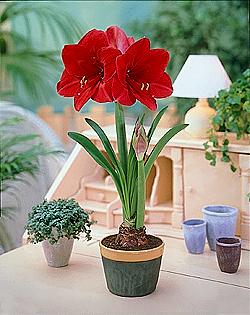 Amaryllis 'Miracle' Picture courtesy www.hadeco.co.zaWhen your potted plants are in full bloom, you may prefer to move them indoors to enjoy, or you may move then into a more shady and secluded spot outdoors, which will keep the blooms looking good for longer. Once the leaves have died down naturally at the end of summer, the containers can be moved into a sheltered part of the garden where it is relatively dry and warm, to over-winter.
Amaryllis 'Miracle' Picture courtesy www.hadeco.co.zaWhen your potted plants are in full bloom, you may prefer to move them indoors to enjoy, or you may move then into a more shady and secluded spot outdoors, which will keep the blooms looking good for longer. Once the leaves have died down naturally at the end of summer, the containers can be moved into a sheltered part of the garden where it is relatively dry and warm, to over-winter.
Amaryllis bulbs take approximately 6 to 8 weeks to bloom once planted out, and if you want blooms at Christmas time, plant them out around the 10th of November. This can be done by manipulating the bulbs to flower at a specific time, by placing them in a paper packet and storing them in the refrigerator. This tricks the bulbs into thinking that it is still winter and they remain dormant. Check the stored bulbs regularly, and if they do start shooting, plant them out immediately.
During summer, allow the leaves to continue to grow and nourish the bulb, and continue to water and fertilise the plant. Towards the end of summer gradually reduce watering so that the leaves die back naturally. Once all the leaves are brown, cut them off and allow the bulb to rest by either leaving it in its pot without watering it, or by lifting and storing the bulb in a paper bag placed in a cool, dry place, for at least 2 months. When the bulb is ready to grow again it will start to produce a green leaf or stem, and can then be planted again in fresh soil.
If you are growing your amaryllis indoors, planting and caring for them is the same as for potted specimens growing outdoors. Indoors they will require very good, bright light, and although they don’t need sun, a little sunlight won’t harm them either. To prevent root rot, water sparingly until the flower stem appears, but when it starts to grow, increase the amount of water you give, and check your plants regularly, because flowering plants are thirsty.
Like hyacinths, amaryllis bulbs can be grown on water. Place the bulbs on top of pebbles or marbles in a glass container and fill with water until just beneath the bulb, and the roots will grow into the water. Amaryllis bulbs grown this way should be discarded once they have finished blooming.
Good amaryllis care will ensure that you enjoy beautiful blooms year after year.
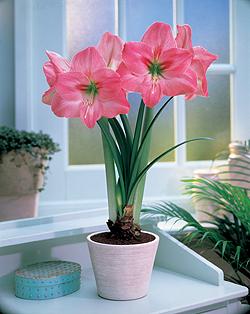 Amaryllis 'Blushing Bride' Picture courtesy www.hadeco.co.zaProblems, Pests & Diseases:
Amaryllis 'Blushing Bride' Picture courtesy www.hadeco.co.zaProblems, Pests & Diseases:
Long stems and flower heads that fall over could be the result of the plant not getting enough light, overwatering, or being exposed to temperatures that are too low. Next year, place your potted amaryllis in a sunnier, warmer position, hold back on water and try rotating the container every few days.
Hand-pick and destroy snails and slugs as well as the black and yellow amaryllis caterpillar or lily borer which eats the leaves and bores down into the bulb.
Red blotches on the leaves are caused by fungi known as Stagonospora curtisii. Try cutting off the affected part of the leaf as soon as you spot signs of this disease.
Warning:
Amaryllis contains the toxic alkaloid lycorine, which can cause symptoms in pets ranging from vomiting, depression, diarrhoea and abdominal pain to excessive drooling, anorexia and tremors. If your cat or dog is showing symptoms of lycorine poisoning, call your local vet. In humans, eating an amaryllis bulb may cause symptoms such as nausea, vomiting, salivation and diarrhoea. North Carolina State University claims that the plant is toxic only if large quantities are ingested.
Corn Plant - Draceana
Pencil Grass - Juncus effuses 'Spiralis'
 This unusual grass-like plant is easy to grow indoors in good light. It needs a moist soil and must be watered regularly all year round. Feed it once a month in summer.
This unusual grass-like plant is easy to grow indoors in good light. It needs a moist soil and must be watered regularly all year round. Feed it once a month in summer.
This strongly architectural plant complements modern architecture in homes and offices.
